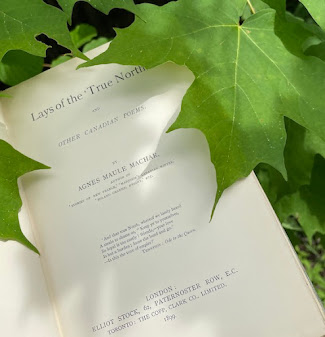Carnac's Folly [Carnac]
Gilbert Parker
Philadelphia: Lippincott, 1922
Carnac Grier is the second son of Quebec lumber baron John Grier. Unlike elder brother Fabian, and much to his father's consternation, he has no passion for the business. Carnac seems so different from the rest of the family; he's not exactly a black sheep, but there is cause for concern. You see, since an early age the boy has devoted himself to art. He both paints and sculpts. We're told that art is everything to him, though this isn't entirely true. Carnac is also interested in politics, and will one day defeat one of the province's most accomplished and powerful politicians to take a seat in the Legislative Assembly. There's also pretty Junia Shale, of whom he's quite fond. Here she is accompanying Carnac on the campaign trail:
Carnac's Folly is not Parker's finest novel. Those who make it to the end will remember it – perhaps not – as a story of a strong-willed young man whose path is guided by his nature. Like other Parker novels, the ending is neatly tied up, and yet I was confused.
Was it his pursuit of a career in art, thus foregoing a share in the family business worth millions? Did it have something to do with his impetuous decision to run for election against the most formidable foe in the province? Or might it be something I missed about his relationship with Junia Shale.
I think it's worth noting the title Carnac's Folly is exclusively American. In Canada and the United Kingdom, the novel appeared as simply Carnac.
Returning to the issue at hand, what was Carnac's folly?
By a strange piece of folly, Carnac's career is almost wrecked and and his love for beautiful Junia Shale brought to naught. While Junia wonders and waits, Carnac struggles desperately against the consequences of his act and also unknown to himself against a family heritage of hate.Got it.
Early in the the novel, Carnac leaves his Montreal family home and sets out to make something of himself in New York. He takes a studio near Washington Square, befriends other artists, and begins painting scenes of the Bowery and the city's nightlife. To paraphrase the omniscient narrator, life was nearly as continental as was possible in a new country.
One day, while walking along Broadway, he saves a young woman from certain death by pulling her from the path of an oncoming streetcar. She is Luzanne Larue, "a fascinating girl with fine black eyes, black hair, a complexion of cream."
Luzanne looks to befriend her rescuer, as I expect is common in these sorts of situations. For his part, Carnac recognizes that what with her black eyes, black hair, and complexion of cream, Luzanne would make a very fine subject for a very fine portrait.
 |
| Luzanne Larue, as imagined by illustrator Walter Lauderback. |
Because it is.
Carnac's marriage to Luzanne hangs over much of the rest of the novel. He worries that it might be discovered and used against him during his electoral run. More than this – much more than this – it affects his relationship with Junia. She has loved Carnac since they were childhood playmates, and cannot understand why he is now so troubled and aloof.
"Every woman has an idea where a man ought to make love to her, and this open road certainly ain't the place."Trivia: The Lippincott front flap errs in referring to Carmac Grier as "Carmac Greer." The rear flap pitches The Gland Stealers by Bertram Gayton, a "comedy of to-day" about a grandpa who believes monkey glands provide the elixir of life.
Access: The American first edition, I purchased my copy earlier this year from a Michigan bookseller. Price: US$20. As is too often the case, I paid much more in shipping.
As I write, eleven Lippincott copies are listed online, beginning at US$5.00. The high end is held by a Nevado bookseller who offers a signed copy at US$214.50. Were it not for the US$47.50 shipping fee I'd recommend the former.























































